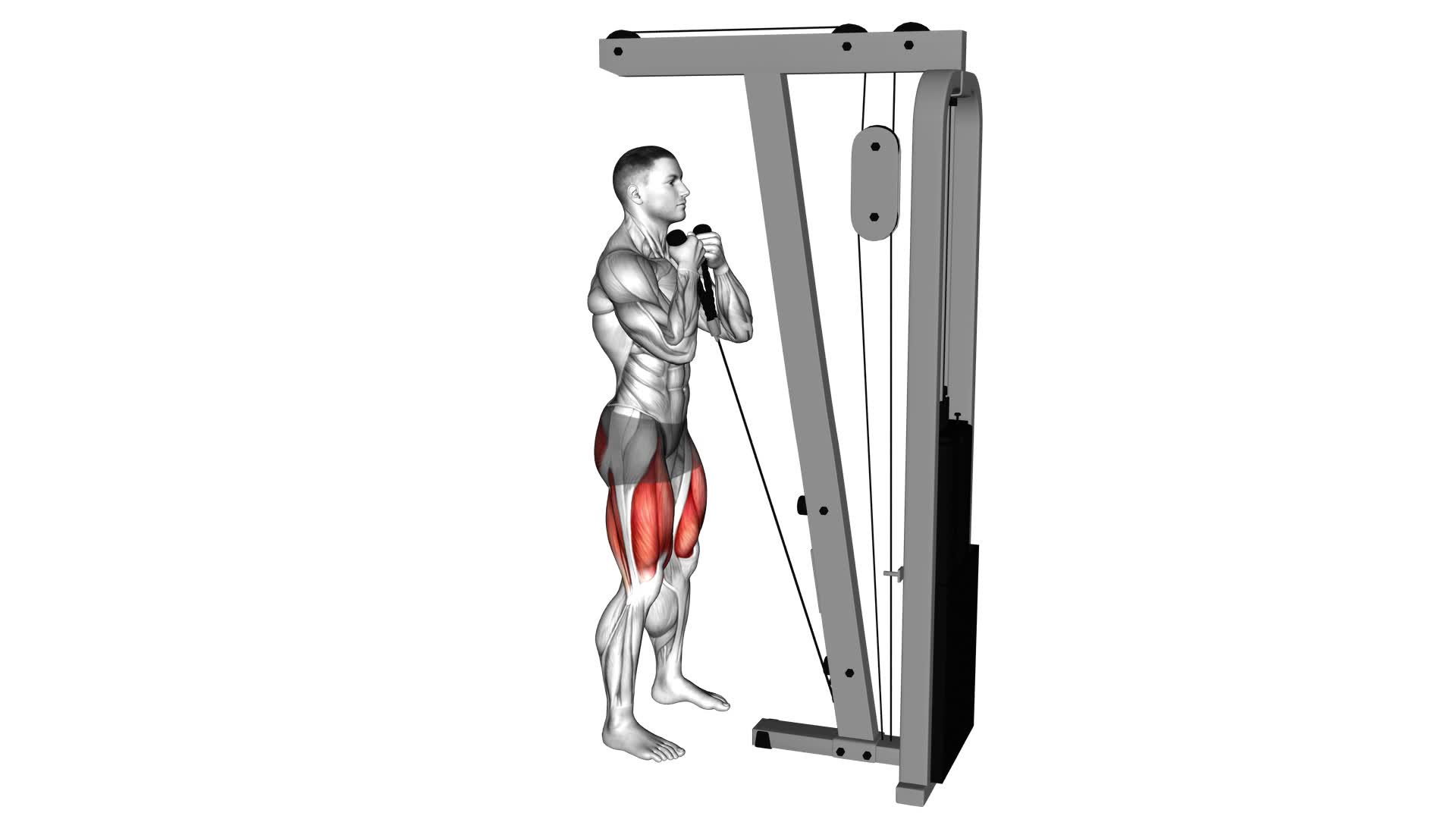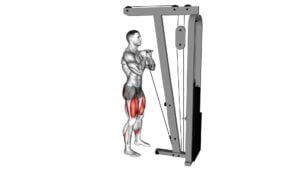Cable Front Squat (VERSION 2) – Video Exercise Guide & Tips

Looking to level up your squat game? Check out the Cable Front Squat (Version 2)!
Watch This Exercise Video
This exercise guide and video will show you how to perform this variation with proper form and technique. Say goodbye to common mistakes and learn how to modify the exercise for different fitness levels.
Plus, discover variations and progressions to keep challenging yourself.
Ready to incorporate the Cable Front Squat (Version 2) into your workout routine? Let's get started!
Key Takeaways
- Cable front squat version 2 offers increased stability and muscle activation.
- Proper form and technique are crucial, including maintaining a neutral spine, aligning knees with toes, and controlling descent and ascent.
- Common mistakes to avoid include rounding the back, leaning too far forward, lifting the heels, using excessive weight, and neglecting full range of motion.
- Breathing properly and engaging the core throughout the movement are essential for optimal performance.
Benefits of the Cable Front Squat Version 2
You'll experience increased stability and muscle activation with the cable front squat version 2. This variation of the cable front squat offers several benefits for your workout routine.
First, it allows you to focus on your breathing techniques, which is essential for maintaining proper form and maximizing your performance. By concentrating on your breath, you can ensure a steady flow of oxygen to your muscles, enhancing their endurance and overall function.
Additionally, the cable front squat version 2 promotes core engagement techniques. As you perform this exercise, you'll feel your core muscles working to stabilize your body, resulting in improved balance and strength.
This exercise targets your quads, glutes, hamstrings, and core simultaneously, making it a highly efficient full-body workout.
As you transition into the subsequent section about proper form and technique for cable front squat version 2, remember to focus on maintaining a neutral spine, engaging your core, and keeping your knees aligned with your toes. Mastering these techniques will help you get the most out of this exercise and prevent any potential injuries.
Proper Form and Technique for Cable Front Squat Version 2
To perform the cable front squat version 2 with proper form and technique, focus on maintaining a neutral spine, engaging your core, and keeping your knees aligned with your toes. Proper form is essential for reaping the benefits of this exercise and reducing the risk of injury. Here are some key points to keep in mind:
- Maintain a neutral spine: Keep your back straight and avoid excessive rounding or arching.
- Engage your core: Activate your abdominal muscles throughout the movement to stabilize your spine and improve overall strength.
- Align your knees with your toes: As you squat down, make sure your knees track in line with your toes to prevent unnecessary stress on the knees.
- Control the descent and ascent: Lower yourself down slowly and maintain control as you come back up, avoiding any sudden or jerky movements.
- Breathe properly: Inhale deeply before you descend and exhale as you push through your heels to return to the starting position.
Maintaining proper form and engaging your core during the cable front squat version 2 is crucial for maximizing the benefits of this exercise. By doing so, you can strengthen your lower body, improve balance, and enhance overall functional fitness.
Now let's discuss some common mistakes to avoid during this exercise.
Common Mistakes to Avoid During Cable Front Squat Version 2
To ensure proper form during cable front squat version 2, it's important to pay attention to a few key points.
First, focus on maintaining a neutral spine and engaging your core throughout the exercise.
Secondly, be mindful of your breathing technique, exhaling as you push through the movement and inhaling as you lower the weight.
Lastly, remember to keep your knees in line with your toes and avoid letting them cave inward.
Proper Form Importance
Avoid common mistakes during the Cable Front Squat Version 2 by maintaining proper form. Proper form is crucial for maximizing the benefits of this exercise and reducing the risk of injury.
Here are five common mistakes to avoid:
- Rounding your back: Keep your back straight throughout the exercise to protect your spine and engage your core effectively.
- Leaning too far forward: Maintain an upright posture to target your quadriceps and glutes properly.
- Lifting your heels: Keep your heels firmly planted on the ground to maintain balance and engage your leg muscles efficiently.
- Using excessive weight: Start with a manageable weight to ensure proper form and gradually increase as you become more comfortable and confident.
- Neglecting the full range of motion: Lower yourself until your thighs are parallel to the ground to fully engage your leg muscles and maximize the benefits of the exercise.
Breathing Technique Tips
Maintaining proper breathing technique is essential during the Cable Front Squat Version 2 to optimize your performance and minimize the risk of errors.
When performing this exercise, it's important to inhale deeply before initiating the squat and exhale forcefully as you return to the starting position. This helps to stabilize your core and maintain proper form throughout the movement.
One common mistake to avoid is holding your breath or shallow breathing, as this can lead to decreased core engagement and potential loss of stability.
Remember to breathe rhythmically and consistently throughout the exercise, allowing your breath to support and enhance your movements.
By focusing on your breathing technique, you can ensure proper core engagement and maximize the benefits of the Cable Front Squat Version 2.
Moving on to the next section, let's explore some effective core engagement techniques.
Core Engagement Techniques
When performing the Cable Front Squat Version 2, it's crucial to focus on engaging your core properly to ensure stability and maximize the effectiveness of the exercise. To optimize your core stability and muscle activation during this exercise, keep the following tips in mind:
- Brace your core by pulling your belly button in towards your spine.
- Maintain a neutral spine position throughout the movement.
- Avoid arching your lower back or rounding your shoulders.
- Breathe deeply and exhale as you push through your legs to stand up.
- Keep your core engaged even during the lowering phase of the squat.
By applying these core engagement techniques, you'll enhance your stability and activate the targeted muscles more effectively.
Now let's explore how to modify the cable front squat version 2 for different fitness levels.
How to Modify the Cable Front Squat Version 2 for Different Fitness Levels
Now let's talk about how you can modify the Cable Front Squat Version 2 to suit your fitness level.
If you're a beginner, you can start by using lighter weights or even just the cable attachment itself to practice the movement.
For those who are more advanced, you can add more weight or try incorporating variations like single-leg Cable Front Squats.
Beginner Modifications for Cable Front Squat
To modify the Cable Front Squat Version 2 for different fitness levels, adjust the weight and decrease the range of motion. Here are some beginner modifications for the Cable Front Squat:
- Start with a lighter weight and gradually increase as you build strength.
- Use a higher cable attachment point to decrease resistance and make the exercise easier.
- Focus on maintaining proper form and technique, rather than lifting heavy weights.
- Limit the depth of your squat by only going as low as comfortable until you gain more strength and flexibility.
- Incorporate assistance exercises, such as bodyweight squats or lunges, to build the necessary strength for the Cable Front Squat.
These modifications will help beginners adapt the Cable Front Squat Version 2 to their current fitness levels and gradually progress towards more advanced variations.
Advanced Variations for Cable Front Squat
To advance the Cable Front Squat Version 2 and modify it for different fitness levels, consider incorporating challenging variations that target specific muscle groups.
Advanced modifications can help increase the intensity of the exercise and provide a greater challenge for those who are more experienced.
One advanced variation is the single-leg cable front squat, which requires balance and stability, while engaging the muscles of the lower body.
Another option is the cable front squat with a jump, which adds plyometric elements to the exercise, further enhancing muscle activation and power.
Additionally, you can incorporate muscle activation techniques such as pausing at the bottom of the squat or using resistance bands for added resistance.
These modifications can take your cable front squat to the next level and help you achieve your fitness goals.
Adapting for Different Strengths
To adapt the Cable Front Squat Version 2 for different fitness levels, you can modify the exercise based on individual strength levels. Here are some modifications for different fitness levels:
- Decrease or increase the weight used on the cable machine to match your strength level.
- Adjust the height of the cable pulley to make the exercise easier or more challenging.
- Use a resistance band around your thighs to provide extra support or resistance.
- Perform the exercise with a stability ball against the wall to increase stability and balance.
- Incorporate pauses at the bottom of the squat to increase time under tension and challenge your muscles further.
Variations and Progressions of the Cable Front Squat Version 2
Explore different ways to advance your cable front squat technique with variations and progressions. By incorporating variations into your cable front squat, you can target different muscle groups and add variety to your workout routine.
One variation you can try is the single-leg cable front squat. This variation challenges your balance and stability while also targeting your quadriceps and glutes.
Another variation is the cable front squat with a pulse. Adding a pulse at the bottom of the squat increases the time under tension and intensifies the workout for your lower body muscles.
Progressions of the cable front squat can also help you take your training to the next level. One progression is to increase the weight on the cable machine. Gradually increasing the resistance will challenge your muscles and help you build strength over time.
Another progression is to incorporate jumps into your cable front squat. This explosive movement will engage your fast-twitch muscle fibers and improve your power and explosiveness.
By exploring these variations and progressions, you can continue to challenge yourself and make progress in your cable front squat technique.
Now let's move on to some tips for incorporating the cable front squat version 2 into your workout routine.
Tips for Incorporating the Cable Front Squat Version 2 Into Your Workout Routine
To maximize your results and effectively incorporate the Cable Front Squat Version 2 into your workout routine, focus on maintaining proper form and gradually increasing the resistance. Here are some tips to help you get the most out of your cable front squats:
- Engage your core: Keep your abs tight throughout the exercise to stabilize your body and protect your lower back.
- Modify the cable height: Adjust the cable attachment to different heights to target different muscle groups and add variety to your workout.
- Vary your foot placement: Experiment with wider or narrower stances to engage different muscles and challenge your balance.
- Breathe properly: Inhale as you lower into the squat and exhale as you push back up. This will help you maintain proper form and provide you with the necessary oxygen during the exercise.
- Gradually increase the resistance: Start with a weight that challenges you but allows you to maintain proper form. As you become stronger and more comfortable with the exercise, gradually increase the weight to continue progressing.
Incorporating these tips into your cable front squat routine will help you build strength, improve your squat technique, and achieve better overall results. Remember to listen to your body and adjust the workout as needed to suit your fitness level and goals.
Frequently Asked Questions
What Are the Potential Risks or Injuries Associated With Performing the Cable Front Squat Version 2?
When performing the cable front squat version 2, it's important to be aware of the potential risks and injuries involved. These can include strain or sprain to your muscles or joints, particularly in the lower body. It's crucial to maintain proper form and technique to minimize these risks.
Additionally, overloading the weight or pushing yourself too hard can lead to more serious injuries such as muscle tears or fractures. Always listen to your body and consult with a professional if you experience any pain or discomfort.
Can the Cable Front Squat Version 2 Be Performed With Other Types of Equipment, Such as Dumbbells or a Barbell?
Yes, the cable front squat version 2 can be performed with other types of equipment like dumbbells or a barbell. By using dumbbells, you can perform a dumbbell front squat, which targets similar muscles as the cable version.
Alternatively, with a barbell, you can do a barbell front squat, providing a different variation of the exercise.
These alternatives can help add variety to your workout routine and target your muscles in different ways.
How Does the Cable Front Squat Version 2 Compare to Traditional Front Squats in Terms of Muscle Activation and Effectiveness?
When comparing the cable front squat version 2 to traditional front squats, you'll notice some key differences in muscle activation and effectiveness.
The cable version provides a unique challenge by incorporating resistance from the cables, which helps to engage your core and stabilizing muscles more intensely. This can lead to increased muscle activation and improved overall strength.
Additionally, the cable front squat version 2 allows for a greater range of motion, enhancing the benefits of the exercise.
Are There Any Specific Warm-Up Exercises or Stretches That Should Be Done Prior to Performing the Cable Front Squat Version 2?
Before performing the cable front squat version 2, it's important to warm up properly to prevent injury and optimize your performance.
Incorporate dynamic warm-up exercises such as leg swings, hip circles, and bodyweight squats to activate the muscles involved in the squat movement.
Additionally, include stretches that target the hip flexors, hamstrings, and quadriceps to improve flexibility.
These warm-up exercises and stretches will help prepare your body for the cable front squat version 2 and enhance its effectiveness.
Can the Cable Front Squat Version 2 Be Incorporated Into a Full-Body Workout Routine, or Is It Primarily Focused on Lower Body Strength Training?
The cable front squat version 2 can definitely be incorporated into a full-body workout routine. While it primarily focuses on lower body strength training, it also engages your core and upper body muscles for stability.
Including this exercise in your routine will help you develop overall strength and improve your balance.
Conclusion
Incorporating the Cable Front Squat Version 2 into your workout routine can provide numerous benefits, including improved lower body strength, stability, and muscle development.
By following proper form and technique, while avoiding common mistakes, you can maximize the effectiveness of this exercise.
Additionally, modifying the Cable Front Squat Version 2 for different fitness levels and exploring variations and progressions can add diversity and challenge to your routine.
Consider adding this exercise to enhance your overall fitness and achieve your goals.

Author
Years ago, the spark of my life’s passion ignited in my mind the moment I stepped into the local gym for the first time. The inaugural bead of perspiration, the initial endeavor, the very first surge of endorphins, and a sense of pride that washed over me post-workout marked the beginning of my deep-seated interest in strength sports, fitness, and sports nutrition. This very curiosity blossomed rapidly into a profound fascination, propelling me to earn a Master’s degree in Physical Education from the Academy of Physical Education in Krakow, followed by a Sports Manager diploma from the Jagiellonian University. My journey of growth led me to gain more specialized qualifications, such as being a certified personal trainer with a focus on sports dietetics, a lifeguard, and an instructor for wellness and corrective gymnastics. Theoretical knowledge paired seamlessly with practical experience, reinforcing my belief that the transformation of individuals under my guidance was also a reflection of my personal growth. This belief holds true even today. Each day, I strive to push the boundaries and explore new realms. These realms gently elevate me to greater heights. The unique combination of passion for my field and the continuous quest for growth fuels my drive to break new ground.







